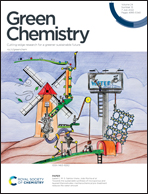Elucidating the role of reactive nitrogen intermediates in hetero-cyclization during hydrothermal liquefaction of food waste†‡
Abstract
Hydrothermal liquefaction (HTL) has emerged as a promising strategy for converting abundant, water-rich organic streams into an energy-dense, sustainable, biocrude. Despite major strides in improving oil yields and process intensification, a key underlying challenge persists in relating the composition of the feedstock to the ultimate fate of nitrogen, which is especially important for biocrude quality. To elucidate how nitrogen partitions into the respective gas, aqueous, oil and solid hydrothermal products, food waste was treated under HTL conditions (15 wt% solids, 575 K reaction temperature, and 1 hour reaction time) and elemental, chromatographic and mass spectroscopy analyses were performed on the products to establish dominant product classes and to close mass, carbon, and nitrogen balances. Liquid products (aqueous and biocrude) were found to contain nearly 60% of the nitrogen, with a majority of the biocrude-phase nitrogen in the form of amides. Ab initio thermodynamic and kinetic simulations on model reactants were used to evaluate potential reaction pathways involving reactive nitrogen intermediates. A subsequent kinetic model was evaluated at reaction temperatures ranging 300–1000 K and for a range of feedstock compositions to identify primary reaction pathways. The Maillard reaction is revealed to be the dominant pathway for converting reactive nitrogen intermediates into observed products, especially those in which nitrogen is present as a heterocyclic aromatic. Subsequent product analysis by Fourier Transform Ion Cyclotron Resonance Mass Spectrometry (FT-ICR MS) confirms strong agreement among the experimental data, kinetic model and proposed Maillard pathways.



 Please wait while we load your content...
Please wait while we load your content...
